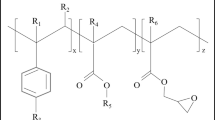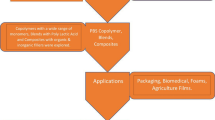Abstract
Biodegradable plastics are among the most promising materials to replace conventional petroleum-based plastics that have caused many adverse impacts on the environment, such as pollution (land, water, etc.) and global warming. Among a range of biodegradable plastics, poly lactic acid (PLA) is not only widely available but also safe to be decomposed after its usage without polluting the environment. PLA is also in parity with other conventional plastics such as PP, PET in terms of various properties suitable for industrial usage such as mechanical, physical, biocompatibility and processability. Thus, PLA has become the most used biopolymers in many industries such as agriculture, automotive and packaging by having these characteristics. Its higher demand has contributed to a stable increment in the global PLA market. In fact, over the years, the market for PLA has grown up and will keep on expanding in the future. Overall, the PLA-based bioplastic would be an excellent substitute for the existing conventional plastics in various applications, hence will serve to protect the environment not only from pollution but also work as a sustainable and economical product. This paper will review all the recent related works and literature on PLA as the biodegradable material regarding its properties, usability, productivity and substitute.




















Similar content being viewed by others
References
Jem KJ, Tan B (2020) The development and challenges of poly (lactic acid) and poly (glycolic acid). Adv Ind Eng Polym Res 3(2):60–70. https://doi.org/10.1016/j.aiepr.2020.01.002
Haider TP, Völker C, Kramm J, Landfester K, Wurm FR (2019) Plastics of the future? The impact of biodegradable polymers on the environment and on society. Angew Chemie—Int Ed 58(1):50–62. https://doi.org/10.1002/anie.201805766
Mangaraj S, Yadav A, Bal LM, Dash SK, Mahanti NK (2018) Application of biodegradable polymers in food packaging industry: a comprehensive review. J Packag Technol Res no. November. https://doi.org/10.1007/s41783-018-0049-y
Muller J, González-Martínez C, Chiralt A (2017) Combination of poly(lactic) acid and starch for biodegradable food packaging. Materials (Basel) 10(8):1–22. https://doi.org/10.3390/ma10080952
Reddy RL, Reddy VS, Gupta GA (2013) Study of bio-plastics as green & sustainable alternative to plastics. Int J Emerg Technol Adv Eng 3(5):82–89. http://citeseerx.ist.psu.edu/viewdoc/summary?doi=10.1.1.413.3777
Casalini T, Rossi F, Castrovinci A, Perale G (2019) A perspective on polylactic acid-based polymers use for nanoparticles synthesis and applications. Front Bioeng Biotechnol 7(October):1–16. https://doi.org/10.3389/fbioe.2019.00259
Pawar PA, Purwar AH (2013) Bioderadable polymers in food packaging. Am J Eng Res (05):151–164
Pan Y, Farmahini-Farahani M, O’Hearn P, Xiao H, Ocampo H (2016) An overview of bio-based polymers for packaging materials. J Bioresour Bioprod 1(3):106–113. https://doi.org/10.21967/JBB.V1I3.49
Storz H, Vorlop K-D (2013) Bio-based plastics: status, challenges and trends. Landbauforschung 4(63):321–332. https://doi.org/10.3220/LBF_2013_321-332
Chen G-Q, Patel MK (2012) Plastics derived from biological sources: present and future: a technical and environmental review. Chem Rev 2012(112):2082–2099. https://doi.org/10.1021/cr200162d
Jiménez L, Mena M, Prendiz J, Salas L, Vega-Baudrit J (2019) Polylactic acid (PLA) as a bioplastic and its possible applications in the food industry. Food Sci Nutr 5(2):1–6. https://doi.org/10.24966/fsn-1076/100048
Singhvi M, Gokhale D (2013) Biomass to biodegradable polymer (PLA). RSC Adv 3(33):13558–13568. https://doi.org/10.1039/c3ra41592a
Bin Park S, Lih E, Park KS, Joung YK, Han DK (2017) Biopolymer-based functional composites for medical applications. Prog Polym Sci 68:77–105. https://doi.org/10.1016/j.progpolymsci.2016.12.003
Gonçalves C, Gonçalves IC, Magalhães FD, Pinto AM (2017) Poly(lactic acid) composites containing carbon-based nanomaterials: a review. Polymers (Basel) 9(7):1–37. https://doi.org/10.3390/polym9070269
Nair AB, Sivasubramanian P, Balakrishnan P, Kumar A, Kurungattu Arjunan N, Sreekala MS (2013) Environmental effects, biodegradation, and life cycle analysis of fully biodegradable ‘Green’ composites. In: Thomas S, Joseph K, Malhotra S, Goda K, Sreekala M (eds) Polymer composites, biocomposites, 1st ed., vol 3. Wiley-VCH Verlag GmbH & Co. KGaA, pp 515–568
Mohan C (2014) Manufacture and mechanical testing of thin film composites composed of poly-lactic acid and nanocrystalline cellulose. California Polytechnic State University
Komesu A, de Oliveira JAR, da S. Martins LH, Maciel MRW, Filho RM (2017) Lactic acid production to purification: a review. BioResources 12(2):4364–4383. https://doi.org/10.15376/biores.12.2.4364-4383.
Myusa N, Katima J, Masanja E, Temu A (2017) Poly (lactic-acid) production _ from monomer to polymer: a review. SciFed J Polym Sci 1(1):1–15
Lasprilla AJR, Martinez GAR, Lunelli BH, Jardini AL, Filho RM (2012) Poly-lactic acid synthesis for application in biomedical devices - a review. Biotechnol Adv 30(1):321–328. https://doi.org/10.1016/j.biotechadv.2011.06.019
Abd Alsaheb RA et al (2015) Recent applications of polylactic acid in pharmaceutical and medical industries. J Chem Pharm Res 7(12):51–63
Farah S, Anderson DG, Langer R (2016) Physical and mechanical properties of PLA, and their functions in widespread applications—a comprehensive review. Adv Drug Deliv Rev 107:367–392. https://doi.org/10.1016/j.addr.2016.06.012
Saibuatrong W, Cheroennet N, Suwanmanee U (2017) Life cycle assessment focusing on the waste management of conventional and bio-based garbage bags. J Clean Prod 158:319–334. https://doi.org/10.1016/j.jclepro.2017.05.006
Qi X, Ren Y, Wang X (2017) New advances in the biodegradation of poly(lactic) acid. Int Biodeterior Biodegrad 117:215–223. https://doi.org/10.1016/j.ibiod.2017.01.010
Castro-Aguirre E, Iñiguez-Franco F, Samsudin H, Fang X, Auras R (2016) Poly(lactic acid)—mass production, processing, industrial applications, and end of life. Adv Drug Deliv Rev 107(April):333–366. https://doi.org/10.1016/j.addr.2016.03.010
Landis AE (2010) Cradle to gate environmental footprint and life cycle assessment of poly(lactic acid). In: Auras R, Lim L-T, Selke SEM, Tsuji H (eds) Poly(lactic acid): synthesis, structures, properties, processing, and applications. John Wiley and Sons, pp 431–441
Morão A, De Bie F (2019) Life cycle impact assessment of polylactic acid (PLA ) produced from sugarcane in Thailand. J Polym Environ 27(11):2523–2539. https://doi.org/10.1007/s10924-019-01525-9
Arjmandi R, Hassan A, Zakaria Z (2017) Polylactic acid green nanocomposites for automotive applications. In: Jawaid M, Salit MS, Alothman OY (eds) Green biocomposites design and applications, 1st ed. Springer International Publishing AG 2017, Switzerland, pp 193–207
Shen M et al (2020) Are biodegradable plastics a promising solution to solve the global plastic pollution? Environ Pollut 263(114469). https://doi.org/10.1016/j.envpol.2020.114469
Zhong Y, Godwin P, Jin Y, Xiao H (2020) Biodegradable polymers and green-based antimicrobial packaging materials: a mini-review. Adv Ind Eng Polym Res 3(1):27–35. https://doi.org/10.1016/j.aiepr.2019.11.002
Gopi S, Amalraj A, Sukumaran NP, Haponiuk JT, Thomas S (2018) Biopolymers and their composites for drug delivery: a brief review. Macromol Symp 380(1):1–14. https://doi.org/10.1002/masy.201800114
Maraveas C (2020) Production of sustainable and biodegradable polymers from agricultural waste. Polymers (Basel) 12(1127):1–22. https://doi.org/10.3390/polym12051127
Gironi F, Piemonte V (2011) “Bioplastics and petroleum-based plastics: Strengths and weaknesses. Energy Sources Part A Recover Util Environ Eff 33(21):1949–1959. https://doi.org/10.1080/15567030903436830
Datta J, Kopczyńska P (2016) Technology From polymer waste to potential main industrial products: actual state of recycling and recovering. Crit Rev Environ Sci Technol 46(10):905–946. https://doi.org/10.1080/10643389.2016.1180227
Scalenghe R (2018) Resource or waste? A perspective of plastics degradation in soil with a focus on end-of-life options. Heliyon 4(e00941). https://doi.org/10.1016/j.heliyon.2018.e00941
Delvere I, Iltina M, Shanbayev M, Abildayeva A, Kuzhamberdieva S, Blumberga D (2019) Evaluation of polymer matrix composite waste recycling methods. Environ Clim Technol 23(1):168–187. https://doi.org/10.2478/rtuect-2019-0012
Awasthi AK, Shivashankar M, Majumder S (2017) Plastic solid waste utilization technologies: a review. IOP Conf Ser Mater Sci Eng 263(022024). https://doi.org/10.1088/1757-899X/263/2/022024
Mangesh VL, Padmanabhan S, Ganesan S, PrabhudevRahul D, Reddy TDK (2017) Prospects of pyrolysis oil from plastic waste as fuel for diesel engines: a review. IOP Conf Ser Mater Sci Eng 197(012027). https://doi.org/10.1088/1757-899X/197/1/012027
Grigore ME (2017) Methods of recycling, properties and applications of recycled thermoplastic polymers. Recycling 2(24):1–11. https://doi.org/10.3390/recycling2040024
Nkwachukwu OI, Chima CH, Ikenna AO, Albert L (2013) Focus on potential environmental issues on plastic world towards a sustainable plastic recycling in developing countries. Int J Ind Chem 4(43):1–13
European Bioplastics, “What are bioplastics?,” Berlin, 2016
Rydz J, Sikorska W, Kyulavska M, Christova D (2015) Polyester-based (Bio) degradable polymers as environmentally friendly materials for sustainable development. Int J Mol Sci 2015(16):564–596. https://doi.org/10.3390/ijms16010564
Ciriminna R, Pagliaro M (2020) Biodegradable and compostable plastics: a critical perspective on the dawn of their global adoption. ChemistryOpen 9:8–13. https://doi.org/10.1002/open.201900272
Jamshidian M, Tehrany EA, Imran M, Jacquot M, Desobry S (2010) Poly-lactic acid: production, applications, nanocomposites, and release studies. Compr Rev Food Sci Food Saf 9(5):552–571. https://doi.org/10.1111/j.1541-4337.2010.00126.x
Mali A, Gavali KV, Choudhari RG, Anekar VP, Gavhane YN (2019) Review on hot melt extrusion technology and it’s application. Int J Sci Res Sci Technol 6(6):253–260. https://doi.org/10.32628/IJSRST196653
Francis LF (2016) Melt processes. In: Materials processing: a unified approach to processing of metals, ceramics and polymers. Academic Press, pp 105–249
Maniruzzaman M, Boateng JS, Snowden MJ, Douroumis D (2012) A review of hot-melt extrusion: process technology to pharmaceutical products. Int Sch Res Netw Pharm 2012:1–9. https://doi.org/10.5402/2012/436763
Dai D, Fan M (2014) Wood fibres as reinforcements in natural fibre composites: structure, properties, processing and applications. In: Hodzic A, Shanks R (eds) Natural fibre composites, 1st ed. Woodhead Publishing Limited, pp 3–65
Ebnesajjad S (2015) Injection molding. In: Fluoroplastics volume 2: melt processible fluoropolymers - the definitive user’s guide and data book, 2nd ed., vol 2. William Andrew, pp 236–281
Ardebili H, Zhang J, Pecht MG (2019) Injection molding. In: Licari JJ (ed) Encapsulation technologies for electronic applications, 2nd ed. William Andrew, pp 183–194
Farris S (2016) Main manufacturing processes for food packaging materials, pp 1–9. https://doi.org/10.1016/B978-0-08-100596-5.21023-8
Khan RM, Acharya G (2016) Plastic injection molding process and its aspects for quality: a review. Eur J Adv Eng Technol 3(4):66–70
Belcher SL (2017) Blow molding. In: Kutz M (ed) Applied plastics engineering handbook, 2nd ed. Elsevier Inc., pp 265–289
Maddah HA (2016) Polypropylene as a promising plastic: a review. Am J Polym Sci 6(1):1–11. https://doi.org/10.5923/j.ajps.20160601.01
Kazmer D (2017) Design of plastic parts. In: Kutz M (ed) Applied plastics engineering handbook, 2nd ed., Elsevier Inc., pp 593–615
Sha L, Chen Z, Chen Z, Zhang A, Yang Z (2016) Polylactic acid based nanocomposites: promising safe and biodegradable materials in biomedical field. Int J Polym Sci 2016. https://doi.org/10.1155/2016/6869154
Narancic T, Cerrone F, Beagan N, O’Connor KE (2020) Recent advances in bioplastics: application and biodegradation. Polymers (Basel) 12(920):1–38. https://doi.org/10.3390/polym12040920
Jabeen N, Majid I, Nayik GA (2015) Bioplastics and food packaging: a review. Cogent Food Agric 1(1117749). https://doi.org/10.1080/23311932.2015.1117749
Bouzouita A, Notta-Cuvier D, Raquez J-M, Lauro F, Dubois P (2017) Poly(lactic acid)-based materials for automotive applications. Adv Polym Sci 1–34. https://doi.org/10.1007/12_2017_10
Akampumuza O, Wambua PM, Ahmed A, Li W, Qin X (2016) Review of the applications of biocomposites in the automotive industry. Polym Compos. https://doi.org/10.1002/pc.23847
Acknowledgements
The authors would like to acknowledge Universiti Malaysia Sarawak (UNIMAS) for their financial and logistic support.
Author information
Authors and Affiliations
Corresponding author
Additional information
Publisher's Note
Springer Nature remains neutral with regard to jurisdictional claims in published maps and institutional affiliations.
Rights and permissions
About this article
Cite this article
Taib, NA.A.B., Rahman, M.R., Huda, D. et al. A review on poly lactic acid (PLA) as a biodegradable polymer. Polym. Bull. 80, 1179–1213 (2023). https://doi.org/10.1007/s00289-022-04160-y
Received:
Revised:
Accepted:
Published:
Issue Date:
DOI: https://doi.org/10.1007/s00289-022-04160-y




